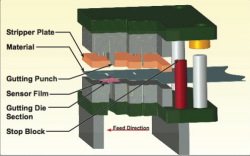
Under Pressure
adamin
Automation maintenance stampingPressure-indicating film cuts stamping tool setup time and production maintenance costs.
Significant effort goes into the design and balancing of the components in a stamping tool. Unfortunately, verifiable data can only be obtained in a press itself, ideally near completion of the die build phase.
To help die and tool shops with this process, Madison, N.J.-based Sensor Products Inc. offers Pressurex, a thin flexible Mylar-based sensor film that captures and records pressure distribution and magnitude between any two mating or contacting surfaces.
“Stamping tool designers, tool-makers and engineers know it’s vital to balance the overall processes of metal cuts and strikes which are required to shape a part progressively in a die,” says Mirco Graenert, owner of Mirco Graenert Consulting Inc. of Newmarket, Ont. “Accurate balancing, by obtaining pressure readings from the various operations, results in higher quality dies and lower future die maintenance costs.”
Graenert, and Shawn Eeles, general manager of Five Star Tooling, an Ontario-based progressive die manufacturer, put Pressurex through a 400-ton progressive die trial to analyze its capabilities. The pair, who have thousands of hours of metal stamping experience between them, were able to identify pressure points that were affecting tool balancing and long-term die maintenance costs.
The test setup used to obtain accurate pressure readings from within the die was a medium size stamping tool which manufactures parts from a coil of steel. The die is about 5 feet (approx. 1.5 meters) in length, manufacturing an arched structural car component running material in excess of .080-inch (2mm) in thickness.

The part runs progressively—the material strip is fed through the die in equal spacings (pregression distance) between each 400 ton press stroke. At strategic locations within this process, the sensor film is applied between mating cutting and forming components as well as bumper blocks, revealing local pressures which can be modified to optimize the balancing of the die.
